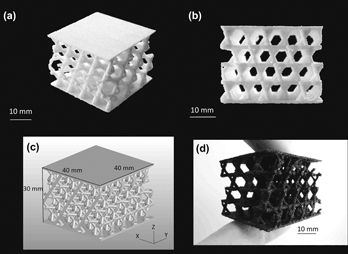Crossref Citations
This article has been cited by the following publications. This list is generated based on data provided by
Crossref.
Zocca, Andrea
Colombo, Paolo
Gomes, Cynthia M.
Günster, Jens
and
Green, D. J.
2015.
Additive Manufacturing of Ceramics: Issues, Potentialities, and Opportunities.
Journal of the American Ceramic Society,
Vol. 98,
Issue. 7,
p.
1983.
Zocca, A
Elsayed, H
Bernardo, E
Gomes, C M
Lopez-Heredia, M A
Knabe, C
Colombo, P
and
Günster, J
2015.
3D-printed silicate porous bioceramics using a non-sacrificial preceramic polymer binder.
Biofabrication,
Vol. 7,
Issue. 2,
p.
025008.
Yan, Xiao
Su, Dong
and
Han, ShuaiShuai
2015.
Phase separation induced macroporous SiOC ceramics derived from polysiloxane.
Journal of the European Ceramic Society,
Vol. 35,
Issue. 2,
p.
443.
Zocca, Andrea
Franchin, Giorgia
Elsayed, Hamada
Gioffredi, Emilia
Bernardo, Enrico
Colombo, Paolo
and
Bandyopadhyay, A.
2016.
Direct Ink Writing of a Preceramic Polymer and Fillers to Produce Hardystonite (Ca2ZnSi2O7) Bioceramic Scaffolds.
Journal of the American Ceramic Society,
Vol. 99,
Issue. 6,
p.
1960.
Minas, Clara
Carnelli, Davide
Tervoort, Elena
and
Studart, André R.
2016.
3D Printing of Emulsions and Foams into Hierarchical Porous Ceramics.
Advanced Materials,
Vol. 28,
Issue. 45,
p.
9993.
Vakifahmetoglu, Cekdar
Zeydanli, Damla
and
Colombo, Paolo
2016.
Porous polymer derived ceramics.
Materials Science and Engineering: R: Reports,
Vol. 106,
Issue. ,
p.
1.
Pierin, Giovanni
Grotta, Chiara
Colombo, Paolo
and
Mattevi, Cecilia
2016.
Direct Ink Writing of micrometric SiOC ceramic structures using a preceramic polymer.
Journal of the European Ceramic Society,
Vol. 36,
Issue. 7,
p.
1589.
Yin, Liuyan
Zhou, Xingui
Yu, Jinshan
and
Wang, Honglei
2016.
Preparation of high porous silicon nitride foams with ultra-thin walls and excellent mechanical performance for heat exchanger application by using a protein foaming method.
Ceramics International,
Vol. 42,
Issue. 1,
p.
1713.
Juraski, Amanda De Castro
Rodas, Andrea Cecilia Dorion
Elsayed, Hamada
Bernardo, Enrico
Soares, Viviane Oliveira
and
Daguano, Juliana
2017.
The In Vitro Bioactivity, Degradation, and Cytotoxicity of Polymer-Derived Wollastonite-Diopside Glass-Ceramics.
Materials,
Vol. 10,
Issue. 4,
p.
425.
Franchin, Giorgia
Wahl, Larissa
and
Colombo, Paolo
2017.
Direct ink writing of ceramic matrix composite structures.
Journal of the American Ceramic Society,
Vol. 100,
Issue. 10,
p.
4397.
Elsayed, Hamada
Colombo, Paolo
and
Bernardo, Enrico
2017.
Direct ink writing of wollastonite-diopside glass-ceramic scaffolds from a silicone resin and engineered fillers.
Journal of the European Ceramic Society,
Vol. 37,
Issue. 13,
p.
4187.
Kupsch, Andreas
Müller, Bernd R.
Lange, Axel
and
Bruno, Giovanni
2017.
Microstructure characterisation of ceramics via 2D and 3D X-ray refraction techniques.
Journal of the European Ceramic Society,
Vol. 37,
Issue. 5,
p.
1879.
Li, Shan
Duan, Wenyan
Zhao, Tong
Han, Weijian
Wang, Li
Dou, Rui
and
Wang, Gong
2018.
The fabrication of SiBCN ceramic components from preceramic polymers by digital light processing (DLP) 3D printing technology.
Journal of the European Ceramic Society,
Vol. 38,
Issue. 14,
p.
4597.
So, Sae-Rom
Park, Suk-Hee
and
Park, Sang-Hu
2018.
Relationship between Mechanical Properties and Porosity of Porous Polymer Sheet Fabricated using Water-soluble Particles.
Journal of the Korean Society of Manufacturing Process Engineers,
Vol. 17,
Issue. 6,
p.
16.
Schmidt, Johanna
and
Colombo, Paolo
2018.
Digital light processing of ceramic components from polysiloxanes.
Journal of the European Ceramic Society,
Vol. 38,
Issue. 1,
p.
57.
Parra-Cabrera, Cesar
Achille, Clement
Kuhn, Simon
and
Ameloot, Rob
2018.
3D printing in chemical engineering and catalytic technology: structured catalysts, mixers and reactors.
Chemical Society Reviews,
Vol. 47,
Issue. 1,
p.
209.
Franchin, Giorgia
Maden, Halide
Wahl, Larissa
Baliello, Andrea
Pasetto, Marco
and
Colombo, Paolo
2018.
Optimization and Characterization of Preceramic Inks for Direct Ink Writing of Ceramic Matrix Composite Structures.
Materials,
Vol. 11,
Issue. 4,
p.
515.
Stabler, Christina
Ionescu, Emanuel
Graczyk‐Zajac, Magdalena
Gonzalo‐Juan, Isabel
and
Riedel, Ralf
2018.
Silicon oxycarbide glasses and glass‐ceramics: “All‐Rounder” materials for advanced structural and functional applications.
Journal of the American Ceramic Society,
Vol. 101,
Issue. 11,
p.
4817.
Sharafeldin, Mohamed
Jones, Abby
and
Rusling, James
2018.
3D-Printed Biosensor Arrays for Medical Diagnostics.
Micromachines,
Vol. 9,
Issue. 8,
p.
394.
Karl, David
Jastram, Ben
Kamm, Paul H.
Schwandt, Hartmut
Gurlo, Aleksander
and
Schmidt, Franziska
2019.
Evaluating porous polylactide-co-glycolide/bioactive glass composite microsphere powders for laser sintering of scaffolds.
Powder Technology,
Vol. 354,
Issue. ,
p.
289.



